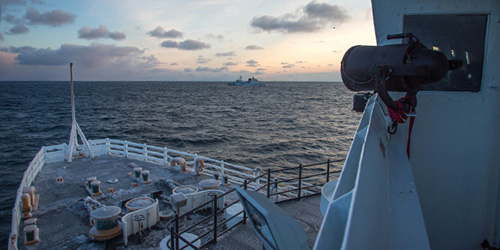
International search in the Bering SeaBy PA2 DIANA HONINGS
December 24, 2014
The South Korean-flagged 326-foot fishing vessel 501 Oryong, consisting of 60 crewmembers from several countries including Indonesia, Philippines, South Korea and Russia, had left South Korea on July 10 to catch pollock, a winter delicacy in South Korea, according to company officials.
The crews of the Coast Guard Cutter Alex Haley and Republic of Korea vessel Sam-Bong conduct a search in the Bering Sea near Chukotka, Russia, Dec. 13, 2014. The Sam-Bong relieved the Alex Haley crew in the search for missing crewmembers from the sunken fishing vessel 501 Oryong.
It was this attraction that led the 501 Oryong to the Bering Sea where on the evening of Nov. 30, 2014, off the coast of the Chukotka in northeast Russia, the crew was hauling its catch when, according to South Korean government officials and the ship’s owners, the vessel was hit with a wave that flooded the boat’s storage chambers with seawater sinking the vessel 109 miles from the nearest point of land. Coast Guard 17th District command center watchstanders in Juneau, Alaska, were alerted by the 501 Oryong’s emergency locator beacon and immediately contacted the Russian Rescue Coordination Center in Vladivostok, since the vessel was in their search and rescue region. With extensive communication between the South Korean Mission Coordination Center and Russian RCC, the Coast Guard learned that a good Samaritan had managed to pull seven survivors from a life raft and one deceased crewmember from the water 3 miles from the sunken vessel. The remaining crew is believed to have jumped into the sea with life jackets on. “Strict compliance with Safety of Life at Sea requirements, frequent training of the crew and a healthy respect for the environment are critical,” said Cashin. “The fact the 501 Oryong had an operational emergency locator beacon and that the international community came together and adopted a common search and rescue alerting system is likely the reason we have seven survivors.” The Coast Guard launched a C-130 Hercules airplane crew out of Air Station Kodiak for a first light search traversing 850 miles to the scene the next morning. Coast Guard Cutter Alex Haley and Coast Guard Cutter Munro, with Coast Guard Air Station MH-65 Dolphin helicopters embarked, were diverted from their current missions to assist in the search as well as several Russian good Samaritans. On Sunday, Dec. 7, two South Korean Navy P-3 maritime search aircraft crews assumed the fixed wing aviation lead, being based out of Joint Base Elmendorf-Richardson in Anchorage, Alaska. The Coast Guard sent two search and rescue planners to help plan their search efforts, brief the crews and debrief upon return. The search continued, and on Saturday, Dec. 13, the South Korean Government Vessel Sambong joined the search. On Monday, the Republic of Korea relieved the Coast Guard in the search. The response was a community effort with actions by the Russian SAR Mission Coordinator, international good Samaritans, the Coast Guard, South Korean government and the U.S. Air Force with a host of Korean P-3s. Though the search was turned over to the South Korean assets, the Coast Guard continues to assist with search and rescue planning using robust ocean models. Ultimately, after more than 24 Coast Guard searches covering more than 4,576 square miles, only seven survivors were located, 27 crewmembers were recovered deceased by the good Samaritans and 26 remain missing. “The sympathies of the Coast Guard go out to those impacted by this tragic maritime loss,” said Commander of Coast Guard forces in Alaska Rear Adm. Dan Abel. “To the families of those known to have perished, we grieve with you. For the families of those who still remain unaccounted, not knowing the fate of a loved one is often more difficult than a sad but definitive conclusion.
Source of News:
|
||
